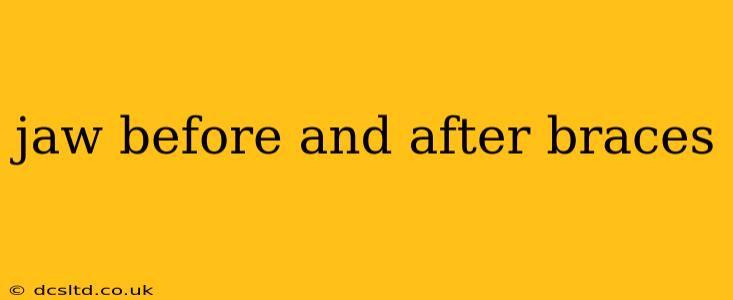Many individuals consider braces to straighten their teeth, but often overlook the potential impact on jaw alignment. Braces can significantly affect the jaw's position and overall facial structure, leading to noticeable changes before and after treatment. This comprehensive guide explores the transformations that can occur, addressing common questions and concerns.
What Happens to Your Jaw During Braces Treatment?
Braces work by applying gentle, consistent pressure to move teeth into their ideal positions. This pressure isn't limited to the teeth themselves; it also influences the surrounding bone and, consequently, the jaw. The changes depend on several factors, including the severity of the initial misalignment, the type of braces used, and the individual's growth patterns. Some individuals might experience a slight shift in their jawline, while others might see more dramatic changes.
How Does Jaw Alignment Affect Facial Appearance?
Jaw alignment plays a crucial role in facial aesthetics. A properly aligned jaw contributes to a balanced and harmonious facial profile. Misalignment, on the other hand, can lead to an asymmetrical appearance, overbites, underbites, or crossbites, which can impact self-confidence. Braces treatment aims to correct these issues, often resulting in a more symmetrical and aesthetically pleasing facial structure.
Common Jaw Changes Before and After Braces:
- Overbite Correction: Braces can significantly reduce or eliminate an overbite by adjusting the position of the upper and lower jaws. This often leads to a more balanced facial profile.
- Underbite Correction: Similar to overbite correction, braces can address underbites by repositioning the jaw, resulting in a more harmonious facial structure.
- Crossbite Correction: Crossbites, where the upper teeth sit inside the lower teeth, can be corrected, leading to improved bite function and facial symmetry.
- Jawline Definition: In some cases, braces treatment can lead to a more defined jawline by subtly adjusting the jaw's position and improving muscle tone. This is often due to improved bite function and the correction of facial asymmetry.
Will My Jawline Change After Braces?
The extent of jawline change varies significantly from person to person. While some individuals may experience subtle changes, others may see more pronounced alterations. Factors influencing the degree of change include:
- Severity of the initial misalignment: More severe malocclusions will typically require more extensive treatment, leading to more noticeable changes in jaw position.
- Age: Younger individuals, whose bones are still growing, are more likely to experience significant jaw changes.
- Type of braces: Different types of braces, such as traditional metal braces or Invisalign, may have varying degrees of impact on jaw alignment.
- Individual bone structure and growth patterns: Each individual’s bone structure and growth patterns are unique, influencing the way their jaw responds to orthodontic treatment.
What if I'm Unhappy with the Changes to My Jaw?
It’s important to have realistic expectations regarding the changes that braces might bring. While orthodontic treatment aims to improve both teeth and jaw alignment, the results are not always predictable. Open communication with your orthodontist is crucial. They can discuss potential outcomes and address any concerns you might have before, during, and after treatment. In rare cases, further procedures might be needed to achieve the desired aesthetic results.
Can Braces Cause Jaw Pain?
Yes, it's common to experience some jaw discomfort during the initial phases of braces treatment. This pain is usually temporary and manageable with over-the-counter pain relievers. Your orthodontist can offer advice on pain management strategies. However, if the pain is severe or persistent, it's essential to contact your orthodontist immediately.
How Long Does It Take to See Jaw Changes?
The timeframe for noticeable jaw changes varies, depending on the complexity of the case and individual responses to treatment. Significant changes might not be apparent immediately but gradually become noticeable over the course of the treatment and after the braces are removed. Retention is crucial following treatment; retainers help to maintain the new jaw position and prevent relapse.
This guide provides a general overview. The best way to understand the potential impact of braces on your specific jaw is to consult with a qualified orthodontist. They can assess your individual needs and provide personalized advice and realistic expectations. Remember, open communication is key throughout the entire process.
